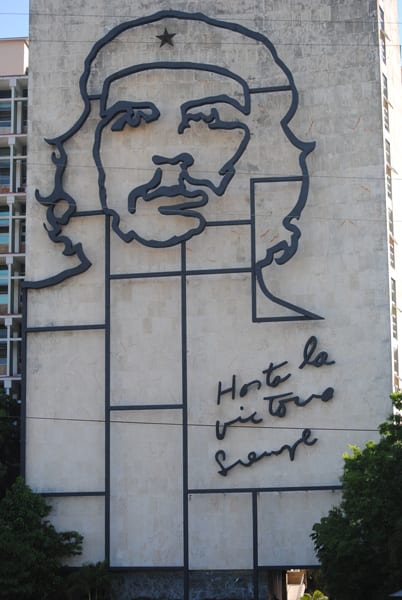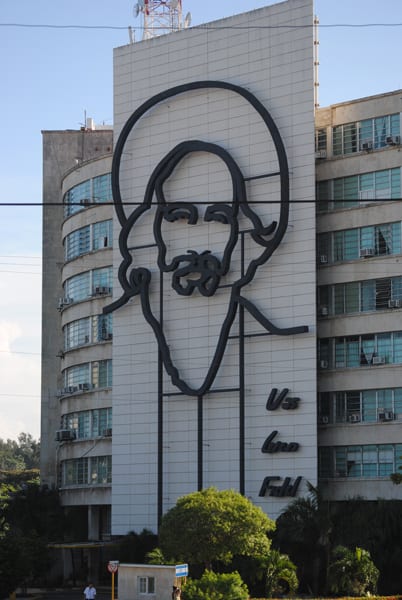In the Presence of Greatness
By Michael Ritchie

HAVANA TIMES — I make no secret of, nor apologies for, my admiration of Fidel Castro’s Cuban Revolution. The ultimate victory of a handful of heroic rebels— many unarmed at first — over dictator Fulgencio Batista’s army, consisting of 37,000 troops, as well as tanks and Mig fighter jets, can be called nothing less than admirable.
Echoing through the Sierra Maestra still today one can hear names such as Raul Castro, Che Guevara, Camilo Cienfuegos, Frank Pais and Vilma Espín, among many others just as valiant.
A testament to their victory, and to the memory of Cuban national hero, Jose Marti, stands in the center of Havana, in Vedado — Plaza de la Revolución (Revolution Square).
As a life-long student of the Revolution, the Plaza was the one site I wanted most to visit in Havana. It was not until my second visit, which coincided with International Workers Day, (Primero de Mayo), that I finally arrived at Revolution Square. Only problem, 600,000 other people arrived at the same time!
It was, after all, May Day— and I had really come to see that as well as the Plaza. But my cab could only get a short way down the Paseo before we found the road blocked by uniformed young revolutionary guards. So I had to walk at least a mile before getting close to the actual Square. Entering was impossible. Both sides of the eight-lane highway were filled with revelers. I was able to see the iconic 358-foot, gray-white marble tower, but that was it.

Still, as the Paseo was lined with huge loudspeakers, I could hear a number of inspirational speakers, including President Raul Castro. And I got some great photos.
My religious/revolutionary experience would have to wait until my next visit, which came in July.
A fiery sun was rising over Revolution Square and a giant 60-foot, gray-white marble statue of Jose Marti stared down pensively at what is basically a giant parking lot. I stared at it for a long while and remembered the words of his poem about Cuba’s constant struggle for independence:
I Have a White Rose to Tend (Cultivo Una Rosa Blanca)
I have a white rose to tend
In July as in January;
I give it to the true friend
Who offers his frank hand to me.
And for the cruel one whose blows
Break the heart by which I live,
Thistle nor thorn do I give:
For him, too, I have a white rose.
No wonder Marti is often referred to as the Apostle of the Cuban Revolution.
He visited Key West, where I now reside, on a number of occasions and gave speeches in hope of raising money for Cuba’s fight for independence from Spain.

One of his speeches was presented from the balcony of a local residence, which was later named in his honor: La Terraza de Marti. In later years, in an act of typical Key West heresy, it was turned into a restaurant/hotel named La-Te-Da, which now presents drag shows.
Back to the Square. Across from the Marti statue and its towering memorial stand two imposing government office buildings, the Ministry of the Interior (MININT) and the Ministry of Communications.
Adorning the facade of the Communications building is a huge steel sculpture of Fidel Castro’s good friend and confidant, Camilo Cienfuegos. Beneath his giant bust, sculpted in his Camilo’s own handwriting, are the words, “Vas bien, Fidel” (You’re doing fine, Fidel). The words were spoken in response to a question his Commandante en Jefe had asked him regarding a victory speech he was giving in 1959. Vas bien, Fidel.
The Ministry of the Interior building hosts another steel sculpture, perhaps one of the most famous in the world, that of Argentine guerilla fighter and Cuban hero Ernesto Che Guevara. During his visit to Havana, US President Barack Obama even posed to have his photo taken in front of the Che sculpture. I won’t comment on whether or not Che would have approved.
Beneath Che’s likeness are the words “Hasta la Victoria siempre” (Toward victory always).
Also in the MININT building is Guevara’s office, which remains today as it was when he left it. The public, however, is not allowed entrance.
There’s a great story regarding Guevara which allegedly occurred in a meeting Fidel held shortly after his victorious march into Havana. It was an organizational meeting, setting up the new Socialist government of Cuba. Who was to head the Interior Department, the Judicial, etcetera. Surrounded by his top commanders, he handed out assignments, one by one. When the question of banks arose, Fidel told the assembled group, “We need an economist. Anyone here an economist?”
Che waved his hand excitedly in response.
“Okay, Che, you’re in charge of banking,” Fidel told him.

Following the meeting, a quizzical Che approached Fidel and wondered, “Why did you appoint me to head banking?”
“I asked for an economist,” Fidel replied.
“Oh,” Che said, “I thought you said communist!”
Thus Che became the head of Cuba’s new banking system.
I hope the story is true because it is so like Che. I should ask Havana Times contributor Elio Delgado-Legon. He is a true revolutionary and would know. (I always enjoy reading his column.)
In the Plaza, you can tour a visitor’s center and go to the top of the memorial for a paltry two CUCs. (The day I was there it was closed due to the presence of some visiting Spanish dignitaries.) If you wander toward the rear of the tower you’ll be whistled at and warned by a docent that you are not allowed to wander there. Just military secrets back there, I suppose.
There is a feeling of being in the presence of greatness in la Plaza de la Revolución. There are also a lot of uniformed soldiers guarding military installations adjacent to the square. One is aware of being watched. For me, that was comforting.






Yes, the Communist Revolutionary Union backed Batista in the 1940 election, but the subsequent presidents, Ramón Grau & Carlos Prío Socarrás of the Authentico Parti did not have support from the Communists. The history of the Cuban armed forces, including their airforce, is well documented on the web. You need not speculate on tenuous possibilities. There were no MIGs in Cuba until the 1960’s.
Terry, you honestly didn’t know that the Soviets didn’t directly enter the picture until after Batista was ousted?! Seriously?!
I see we run in the same circles Terry!
Eden: My use of the word “dementia” was simply me exercising “poetic license” – you really need to look it up!
Just kidding btw………
Maybe a better description of Elio and Michael is “bat sh*t crazy”?
RWS
According to this account supporters of the Communist Party of Cuba were part of the Batista cabinet back in 1940. I don’t know how long this friendly relationship lasted, but it is in the realm of possibility that the USSR could have sold armaments to Cuba, even if it’s not very likely.
http://www.iww.org/history/library/Dolgoff/cuba/6
Check the link I posted above. Cuba has a few WWII vintage propellor fighters. The only jets they had were a few trainers. Cuba did have a significant number of well trained pilots, and most of them left for Florida when Castro seized power, a few to return in the Bay of Pigs invasion.
We can absolutely rule out that Cuba had any MIGs. Russian pilots flew MIGS from Cuba during the Missile Crisis, but the first Cuban MIG regiment was not formed until 1963.
RWS, good to see you here. Never mind Eden, he has his own dementia to deal with… ehem! I mean, ill founded political views. 😉
The revolution has ended? It seems that even YOU are not immune to inaccuracies.
You really need to look up the definition of dementia.
Having ill founded political views is not dementia.
“… So far, I have nothing to indicate that Batista had MIGs, although I don’t have enough information rule it out as yet…”
Come on Ken, you don’t have to Google anything, you simply have to know the tiniest little bit about Revolutionary history.
The Soviets didn’t support Batista, the Americans did. The Soviets supported Castro, thus the introduction of MIGs after the Revolution ended.
This is really, really basic history.
I have googled Cuba, Batista, and fighter jets. So far, I have nothing to indicate that Batista had MIGs, although I don’t have enough information rule it out as yet. Batista did have military aircraft, but it’s not clear that any of them were jets.
What a load of crap! Batista did not have “Mig fighter jets”. As a “lifelong student if revolution”, Michael, where did you ever read that the Cuban airforce flew MIGs during the 1950s?
“The FAEC (Fuerza Aérea Ejército de Cuba – Cuban Army Air Force) was a semi autonomous organisation mainly equipped with US made World War II vintage aircraft such as B-26 “Invaders” and P-47 “Thunderbolts” (the only jets were T-33 combat capable trainers), transports and other auxiliary types as well as floatplanes for it also had a maritime role.” http://www.acig.info/CMS/index.php?option=com_content&task=view&id=259&Itemid=0
It was not until 1963 that the first Cuban MIG regiment was formed, when the Soviet Union sent the jets to their new client, Castro.
What a joke that you admire Che Guevara, the “communist economist” who wanted to abolish money entirely. Fidel over-ruled him and instead, they simply confiscated every Cuban bank account over $100 and converted what remained into soon to be worthless Cuban pesos.
Your thrill at being in la Plaza de la Revolution would not be quite the same if you had lived through the socialist disaster which Fidel, Raul & Che had inflicted on the Cuban people. Being a revolutionary tourist is not the same thing as living it.
“… over dictator Fulgencio Batista’s army, consisting of 37,000 troops, as well as tanks and Mig fighter jets, can be called nothing less than admirable…”
Your research is hugely lacking, Michael.
There were no MIGs in Cuba until May of 1961. They were given to Castro, not Batista, who was of course long gone by then.
Elio is an old man suffering from dementia, and based on the drivel I just read, you’re not far behind him. Che certainly wasn’t an economist – he was a butcher.
It is not the result of the revolution but the lack of progress for the Cuban people since that concerns me! The people or at least some are going hungry and the Castro brothers seem quite unable to solve the problem!